Subtotal: $
Checkout-

In These Surreal Times
-

Ramadan
-

Poem: Ordinary Saints
-

Benedict Option: Signs of the Times
-

Forum: Even If He’s Wrong
-

Forum: Not the Full Story
-

Forum: The Pentecost Option
-

Forum: Not Optional
-

Editors’ Picks Issue 13
-

Fannie Lou Hamer
-

Nature Is Your Church?
-

Afternoon at the Jerome
-

The Real World to the Rescue
-

Readers Respond Issue 13
-

Family and Friends Issue 13
-

Not a Saint, but a Prophet
-

Inwardness in a Distracted Age
-

On Inner Detachment
-

Activist Mystics
-

Marguerite Porete: The Noble Virtue of Charity
-

Simone Weil: An Encounter
-

Waiting in Silence
-

Saving Silence
-

Poem: A Lens
-

Giving God Our Attention

An Impossible Hope
Three men in Syria showed me what Jesus looks like.
By Stephanie Saldaña
July 17, 2017
Available languages: Español
Next Article:
Explore Other Articles:
A Syrian painter recently told me that we all have a map in our bodies, composed of the places we have lived, that we are constantly in the process of redrawing. A street from our childhood might be traversed by a train car in which we once fell in love. A garden from a year in London might yield, unexpectedly, a rose from the graveside of our grandmother. This map not only marks who we are but informs the way in which we encounter the world. The painter, a refugee originally from Damascus, was busily sketching the buildings of Istanbul, trying to move his map forward to the new country he now called home.
I am writing my map in the other direction. I am trying to remember who I am.
I lived in Syria more than a decade ago, and it was there that I met my husband. In a Syrian monastery perched up in the clouds, I rediscovered my faith. In Damascus I learned the Arabic that I still speak daily, and in a crumbling room in the Christian Quarter I began to write my first book. If my body is a map, Syria is the crossroads.
But I cannot go back. Now when I meet Syrians who have fled their country – living in refugee camps in Jordan, in the streets of Istanbul, in cafés in France – I ask them to tell me about the world they left behind. I sketch the details into the map of my body.
There were women who dried red peppers on the roofs of their houses in the old city of Aleppo. In Deir ez-Zor, a suspension bridge straddled the Euphrates River before it collapsed. A church in Homs was said to hold the belt of the Virgin Mary. In a garden in Daraa, we planted olive, lemon, orange, peach, and fig trees.
Every detail is a yes against the void. The 450,000 people dead. The estimated eleven million displaced.
There were two different kinds of apricot trees in the fields near Qaboun.
At the heart of my map is a monastery, and at the heart of that monastery is a man. To write this, I must remember him also and write him back into the map of my heart, which will not be easy. For he, too, has disappeared.
I was twenty-three the first time I journeyed to Deir Mar Musa, an ancient monastery high up on a cliff in Nebek, two hours north of Damascus. I was traveling through Syria for the first time, and rumor had it that one could visit a monastery in the desert that stood shining like a pearl, and that you could only get there by climbing a flight of 350 stairs. There was no need to tell anyone in advance that you were coming, and the monks and nuns who lived there would allow you to stay as long as you wanted. The abbot was said to be an eccentric Italian, the community spoke Arabic, and the frescoes in the chapel were some of the most important in the entire Middle East.
I took a bus to Nebek and a smaller minivan into the desert. At some point the driver swerved onto a path that seemed to be headed nowhere, then eventually stopped. I looked up. The monastery was almost dreamlike, suspended. I began climbing, one step after another, for what must have been half an hour, ascending skywards amongst silence and the chiming of goat bells. At the top of the stairs, I met Father Paolo Dall’Oglio, a man as unlikely as the monastery itself.
Today, people often ask me what he was like, and the truth is that it is difficult to capture him in words. Father Paolo was less a person than a force. He stood well over six feet tall, with wide shoulders and a deep baritone voice. He switched effortlessly between English, French, Arabic, and Italian, and he had taken up the habit of speaking like an old villager, in a dialect sprinkled with Arabic proverbs, like someone’s grandfather. He wore plastic house sandals under his monastic robe. He liked eggs for breakfast. He was always trying to quit smoking.
He was a Roman and a Jesuit, both of these things through and through – passionate and always speaking with his hands, obsessed with the Jesuit notion of the magis, the idea that there is always more we can do for Christ. Deir Mar Musa, the monastery he founded in a difficult country and an even more inhospitable desert, was proof of that magis. He had first come to the monastery when he was a student of Arabic in Lebanon, in the middle of the Lebanese Civil War. It was 1982, and Christians and Muslims in Lebanon were killing one another. He traveled on retreat to a ruined monastery in the Syrian desert, where he spent the night sleeping beneath a ceiling of stars. He prayed and eventually had the vision that would determine the course of his life: one day he would return to the monastery and restore it out of the ruins, creating a monastic community dedicated to prayer, contemplation, and hospitality. Yet it would not be just any monastery. The monks and nuns who took their vows there would promise to live their lives in dialogue with Islam.
It was an impossible hope, made in the depths of a sectarian civil war.
By the time I arrived, some eighteen years later, Deir Mar Musa was up and running. The stunning medieval frescoes of the church had been restored. A small community of monks and nuns had formed, named Al-Khalil, after Abraham, the khalil or special friend of God in the Quran, the common father of Muslims, Christians, and Jews.
I met Father Paolo again in 2001, as a journalist profiling the monastery after 9/11. After I diligently questioned him he turned the interview on me. I began to cry. This was the moment he became not an abbot in the desert but my spiritual father. Three years later I moved to Syria to study Arabic, and Father Paolo became a regular fixture in my life as I traveled out to the monastery on weekends and eventually completed the Spiritual Exercises of Saint Ignatius of Loyola – a month of silence and directed retreat – under his guidance. When I climbed the stairs, he was often waiting in the courtyard, not for me but for whomever happened to be climbing the stairs. Later I would come to understand that, for him, everything depended on those encounters. For Father Paolo, those who would visit the monastery were tied up in his destiny. God sent them there.
Perhaps that was what unsettled so many of us who climbed those stairs, from all over the world: his insistence that this meeting was not an accident. Why did we come? Why did God bring us to the deserts of Syria? What does God desire for us to do in the world? He was never shy in asking the question.
It was in those years that Father Paolo taught me the theology of the sacred encounter. He believed that we must be changed by our meetings: with humans, with books, with religious traditions, with teachers living and dead. Meetings were our encounters with Christ himself, who came to us in a body. For this reason, Father Paolo’s love of Christ was made manifest in his love of other things seemingly unrelated: his passionate love of the Quran, which he read often and quoted regularly, to both Muslims and Christians; the Islamic writings of mystics such as al-Hallaj; and the Arabic language itself, which he was so devoted to that he often corrected Syrians who mispronounced words during the readings of the Mass. He was attached to Louis Massignon, the great French Catholic scholar of Islam, as well as Massignon’s friend Charles de Foucauld, the founder of the Little Brothers of Jesus, who had lived the last part of his life among the Muslims of Algeria. He was also deeply influenced by Gandhi and the writings of Simone Weil. Father Paolo once told me that all of us live in a chain of human beings, both living and dead, and our souls speak to one another.
He was an abbot, but he referred to himself most often as a monk. He was also a scholar, amassing a library in the desert that contained books in several languages on Eastern monasticism, Islamic mysticism, and philosophy. If you wanted to make him happy, you could arrive at the monastery with a chicken for the kitchen or a book for the library.
He spoke to me in English. He burst to life when Italian visitors arrived and he could converse in his mother tongue. He wrote in French. He prayed in Arabic. Every year, he fasted during Ramadan.
In short, he was a complicated man.
In the Ayat An-Nur, the Verse of Light, the Quran speaks of God’s light being like “a niche, within which is a lamp; the lamp is within glass; the glass is as if it were a pearly [white] star lit from [the oil of] a blessed olive tree, neither of the east nor of the west, whose oil would almost glow even if untouched by fire.” Father Paolo once told me that he wondered if that “light” was the light that early monks lit in the desert.
The monastery of Mar Musa was as much for Muslims as it was for Christians, and Father Paolo would often declare that he was in love with Jesus, but also with Islam. In private conversations, he referred to his relationship with Islam as akin to marriage. He tried to express this love in the tiniest of details, things that would go mostly unnoticed by others but which spoke to a consuming desire to make Muslims feel that the monastery was their home. He left the wall in the chapel facing Mecca free of icons, in case Muslims wished to pray inside. He explained the frescoes of the church in Quranic terms when Muslims came to visit, so that Abraham became the Prophet Abraham. We all took off our shoes when we entered the chapel, as in a mosque. Even the opening prayer every evening, when we sang out nur ala nur, or “light upon light,” over and over again, resonated not only with the gospel, where Jesus is the “light of the world,” but with the Quran’s Verse of Light, where “Allah is the light of the heavens and the earth.”
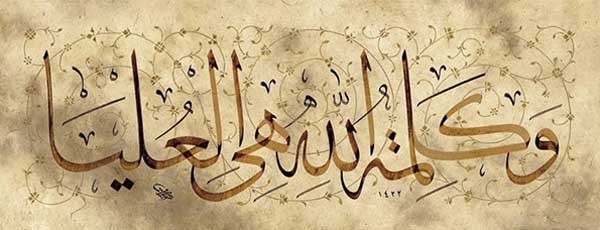
“God’s word is what forever remains supreme.” Calligraphy courtesy of Raamiz Ziad
For Father Paolo, those who would visit the monastery were tied up in his destiny. God sent them there.
Every year, thousands of Muslims visited the monastery, and from the courtyard we could look down and watch them climbing the stairs from the valley below. Families would ascend on Friday afternoons after their picnics in the valley. Sheikhs would climb the stairs. Sufis would ascend to perform their chants. At lunch, the tables filled with young Christians chatting amicably with women in headscarves.
For Father Paolo, these meetings were not unlike those meetings in the Bible when the angels appeared as strangers and those receiving them were almost universally afraid. Many of the most significant moments in the text rely on welcoming an angel. The angels appearing to Abraham had special resonance for a community named in his honor, but it was the Annunciation, the angel Gabriel appearing to Mary, that I most vividly remember Father Paolo discussing.
We were at the point in the Spiritual Exercises when the angel appears to Mary. Mary says yes. This yes, mouthed in the face of uncertainty, allowed God to become incarnate. And so, Father Paolo believed, it is with us. Each time that we meet the Other and overcome our fear, each time we have the courage to say yes to the mysterious Stranger, who in the Middle East often comes as a Muslim guest, then the incarnation happens again. God appears among us in this love, this companionship, this meeting. Father Paolo had little patience for words such as “tolerance” to describe the interaction between Christians and Muslims. He was after something much more profound: a world in which we need one another to be complete, a world in which we cannot live without one another because our encounter with the divine depends upon this destined meeting. Father Paolo was not interested in mere coexistence. He was interested in miracles.
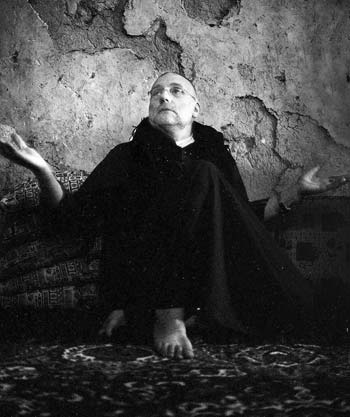 Father Paolo Dall’Oglio in Nebek, Syria, 2012 photograph courtesy of hailang wu / Flickr
Father Paolo Dall’Oglio in Nebek, Syria, 2012 photograph courtesy of hailang wu / Flickr
Already a subscriber? Sign in
Try 3 months of unlimited access. Start your FREE TRIAL today. Cancel anytime.
If you zoomed out from that map in my body, you would see that Mar Musa was part of a larger constellation of bodies dedicated to what might have seemed impossible in other countries: Christians and Muslims living together, bound up in one another’s lives. To be a Christian in Syria during that time was to be able to participate in a remarkable church, where Christian priests were presiding over flocks of Christians and Muslims alike. Outside the nearby city of Homs, there was a farm called Al-Ard, a center run by the Dutch Jesuit priest Frans van der Lugt, who had lived in Syria for nearly fifty years and who, like Father Paolo, was fluent in Arabic. He took care of children with disabilities, Muslim and Christian alike, and young Syrians would visit the center to volunteer and spend time with him and the residents. He led Zen meditation classes; I have a photograph of him, in his late sixties, standing on a simple straw mat with his hands in the air, leading Syrians in stretching exercises.
Father Frans was very different from Father Paolo. He was thin, unassuming, and balding, with gray hair and a kind face. He devoted himself to the children in his care. His theology was bound up in a profound sense of our common humanity, something I would think of as less Abrahamic and more Adamic. He became famous for his annual walks during which Muslims and Christians would trek together through Syria for days, befriending one another and falling in love with the landscape of their country as they struggled to keep up with this remarkable elderly man who led them. When they lagged, he encouraged them: “Lil Iman! Go forth!”
Finally, the third priest: Father Jacques Mourad, who had founded the community of Mar Musa with Father Paolo, helped to build and was now leading the church of Mar Elian in Al-Qaryatayn, one hundred kilometers north of Mar Musa on the road to Palmyra. Father Jacques was the only native Syrian of the three. He had a sweetness and quiet dignity about him and an incredibly beautiful singing voice. We loved it when he would visit Mar Musa and sing in the Syriac language during the Mass. In Al-Qaryatayn, a village that was home to both Christians and Muslims, he was well known for his deep relationship with Muslims as well as his devotion to his Christian faithful. But unlike Father Paolo, who was prone to grand statements, and Father Frans, who could walk across a country, Father Jacques quietly went about his work, loving his neighbors and never letting anyone claim that he was extraordinary.
Love and happiness, all of life itself, is possible on the cross, for it is here that redemption happens.
History would write about these three men separately, but they were part of a single world. Father Paolo, Father Frans, and Father Jacques were constantly crossing paths, as were the young people who loved them. These young people at Mar Musa were also often in Al-Qaryatayn or Al-Ard, forming overlapping circles. It was a unique moment, less than eight years after the Catholic monks of Tibhirine had been martyred in Algeria. Dom Christian de Chergé, Tibhirine’s French abbot, had formed a dialogue group with Muslims and had studied the Quran and developed a deep love of Islam, describing his love for Algeria and Islam as that of “a body and a soul.” During the Algerian Civil War, the monks at the monastery had decided to remain in the country with their Muslim neighbors, an act of solidarity that cost them their lives.
Father Paolo and I held a conversation that we returned to each time we spoke. It concerned his idea that our deepest happiness was possible only on the cross, and began one day when he quoted Simone Weil, who had once said: “When I think of Christ on the cross, I commit the sin of envy.”
I accused him of making an idol out of suffering; he accused me of making an idol out of happiness. The conversation began in 2004, and would continue for the next nine years.
When Father Paolo flew to France to officiate at my wedding, during the sermon he brought up the cross again. It was an odd statement to make during a wedding, but he insisted on it. Love is only real if it is faithful on the cross. Marriage will inevitably have struggles, but we are called to love in the midst of them.
Over the years, he would bring it up repeatedly, this belief in redemption through the cross. I came to understand that his life choices could not be understood merely through his love of Islam but that they had to be paired somehow with his desire to be faithful to the redemption of the cross. He had decided to build a monastery in a desert, to enter into one of the world’s most difficult places and to love there. In time, I came to think of his theology as simple: “the theology of fidelity,” or, as I liked to call it, “the theology of staying put.” We never abandon those we love.
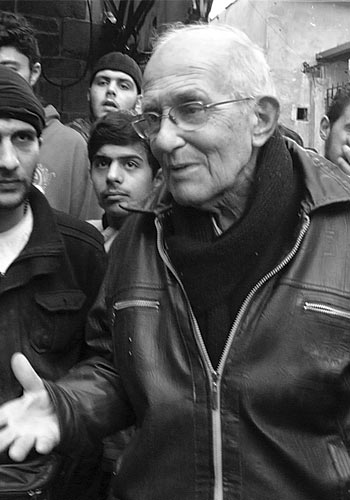 Father Frans van der Lugt in the besieged area of Homs in January 2014, urging fellow residents to be patient despite severe shortages of food and medicine Photograph from REUTERS / Thaer Al Khalidiya
Father Frans van der Lugt in the besieged area of Homs in January 2014, urging fellow residents to be patient despite severe shortages of food and medicine Photograph from REUTERS / Thaer Al Khalidiya
Already a subscriber? Sign in
Try 3 months of unlimited access. Start your FREE TRIAL today. Cancel anytime.
When the Syrian Civil War broke out in 2011, it quickly enveloped the world I have described, with protests soon centering on Homs, a Muslim city with a large Christian population. Father Paolo criticized the government openly, urging UN intervention. He was finally exiled from Syria in June of 2012.
In an interview with National Public Radio he said, “It would be better for me to be dead with the martyrs of this country than to go away in exile. I have offered my life for the future of this country, and I wish to stay in full solidarity with them, so I will come back.”
Exile was perhaps the cruelest punishment for a man whose theology was based on fidelity. I spoke to him many times in the months that followed. I will always remember the last time, in July of 2013, when he called to tell me that he was traveling back to Syria after all. He had already snuck into the country before, and he had called me before that trip also, but this time felt different. I did not know when he was going. I did not know why. He wanted to speak, one last time, about love on the cross.
That morning, I had happened to read an interview in The Paris Review with the Polish poet Czesław Miłosz, who had also spoken of Simone Weil. Miłosz had noted that what drew him to her was her recognition of the reality of evil in the world. And yet she had also written about grace, the size of a mustard seed. “The little grain of mustard seed is really the kingdom of God, grace, and goodness,” Miłosz explained, “small when compared with the evil in the world.”
When Father Paolo asked me again about what I thought about choosing to suffer on the cross, I answered that Simone Weil’s love of the cross could only make sense in light of this “mustard seed of grace.” In a world in which there can be more evil than good, the point cannot be to defeat evil by conventional means. We will be overpowered, often outnumbered. We can overcome only through grace. Fidelity to the cross can only mean our willingness to go to difficult places, carrying that seed, and to believe that grace is transformative.
Of course, I asked him not to go. He told me that he had to. So I told him to carry that mustard seed of grace, to the darkest place in the world.
On July 29, 2013, Father Paolo went to meet with members of what would later be known as the Islamic State near Raqqa, hoping to negotiate the release of hostages. He has not been heard from since. We have not stopped waiting for him.
In the meantime Homs was under siege and the inhabitants were starving. Father Frans van der Lugt, now seventy-five years old, left Al-Ard and moved into the Jesuit residence in Homs’s Old City. Refusing to leave his flock even as the fighting continued, he climbed onto his bike and rode through checkpoints, passing out bread. When there was no bread, he starved with his neighbors, subsisting on olives and a broth of weeds. Eventually the siege ended, but some of the families did not leave and so he stayed with them. On April 7, 2014, a gunman knocked on the door and shot him to death.
The tomb of Father Frans in the Old City of Homs is visited by both Muslims and Christians.
Father Jacques Mourad continued on despite the increasing danger, using the aid money he received from church organizations to help the Muslim and Christian families in al-Qaryatayn, many of whom had fled from other areas. He negotiated for the village to be a zone safe from fighting, so that villagers would be protected. But in May of 2015, just days after they took Palmyra, ISIS militants kidnapped him and transferred him to a prison in Raqqa. The monastery of Mar Elian was razed to the ground. He was brought back to al-Qaryatayn and put under house arrest. Eventually, no doubt with the help of local Muslims, he escaped.
When I set out to write this, I wanted to write about “impossible hope.” But when I started writing, all I could think about were these men: Father Paolo, Father Frans, and Father Jacques.
Of course, Father Paolo was proven right in the end. Love and happiness, all of life itself, is possible on the cross, for it is here that redemption happens. The three of them chose to remain faithful to their flocks, not because they idolized suffering but because they knew that this was, oddly, choosing life. It was choosing love. It was believing in grace the size of a mustard seed, stronger than everything, even death.
The tomb of Father Frans in the Old City of Homs is visited by Muslims and Christians. A center for refugees in Lebanon has been dedicated in his name. This year, a group of Syrians now exiled in Europe who knew Father Frans started an annual walk in his memory.
Father Jacques is alive and well, serving as a priest in a monastery in Iraqi Kurdistan that welcomes Christian refugees who have fled from the Nineveh Plains.
Against all odds, the monastery of Mar Musa continues, perched high on a cliff at that strategic spot between Aleppo, Homs, and Damascus, between Iraq and Lebanon, in the heart of the cross. The community of Al-Khalil has remained faithful throughout the war. Recently, one of the monks of the community, Jihad Youssef, posted a picture of the mountains around the monastery, green and full of flowers in bloom.
He wrote: “Who would believe that this is the desert?”
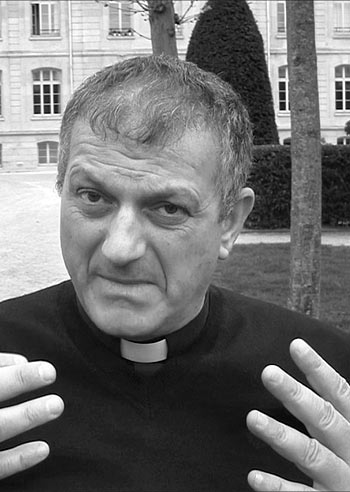 Father Jacques Mourad, 2017 Photograph from AED France, videostill from Carême 2017: le message du Père Jacques Mourad
Father Jacques Mourad, 2017 Photograph from AED France, videostill from Carême 2017: le message du Père Jacques Mourad
Already a subscriber? Sign in
Try 3 months of unlimited access. Start your FREE TRIAL today. Cancel anytime.
The Mosaic Stories is a story-telling project that chronicles the endangered cultural heritage of the Middle East, especially Iraq and Syria. At a time when war and terror are dismembering traditions and communities, it profiles ordinary people in the region: musicians, cooks, soap makers, wedding dancers, members of religious communities, farmers, mothers. In the words of Stephanie Saldaña, who has helped spearhead the project: “It’s the diverse people of the Middle East – not just its historic architecture – that is the region’s most precious heritage.” See mosaicstories.org.
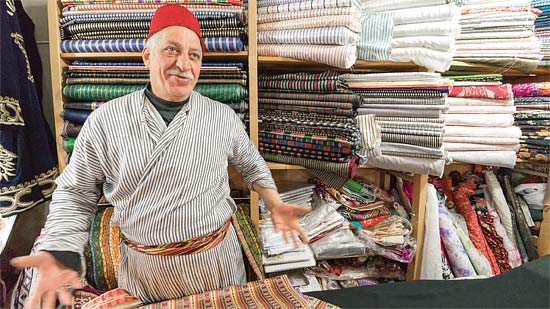
Photograph from mosaicstories.org
Already a subscriber? Sign in
Try 3 months of unlimited access. Start your FREE TRIAL today. Cancel anytime.



































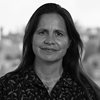
Lawrence
Such a lovely story. Perhaps the author would be interested in the book, "In The Steps of the Master" by H. V. Morton, from 1934. Of great interest is "The Removal of Cares" by Abdal-Qādir_al-Dschīlānī, an ancient mystic. I'm sure the author knows that the translation of "Islam" into English is "Submisssion", which is exactly what Jesus did in the Garden of Gethsemane. I recently reviewed a book - "The Commonalities Between Christianity and Islam", which she may like. Best regards
Julie Prescott Burgess
Dear Stephanie, your words have moved me to tears and describe my own relationship with the people of Syria and especially the churches. I have traveled there over the past nine years as a Presbyterian in relationship with the Presbyterians there. In that time I came to know of Fr. Frans. Although I never had the privilege of meeting him, I have prayed at his tomb in the Jesuit monastery courtyard of Homs. I wrote this blog after one of those trips: jpburgess.me/2014/12/02/on-meeting-mazar-in-homs/ On my most recent trip just this past February I had the chance to spend a brief moment of time in Nebek with the Presbyterians there. Now I need to return and find those steps and climb them to Deir Mar Musa. Thank you for the gift of your words about these men who changed your life and inspired a deeper faith. This has been my experience as well.
Kathy Poupart
I all too often think that we in the West go through the motions of faith. In reading this article, we come face-to-face with do-or-die, committed-to-the-core, faith in God and service to His children. These three men and those they serve move me deeply. I am humbled, and I am also reminded of the depth of faith we may live if only we allow Christ to work freely.
Mervyn Maciel
Stephanie Saldana's article about the three men who "showed me what Jesus looks like" meant so much to me as I work with the Charity here in England that supports persecuted Christians in Syria as in other parts of the world. Some of my colleagues were in contact with Father Jaques Mourad and knew of the plight of Frs. Frans and Paolo - brave men who knew what the love of the cross really meant.